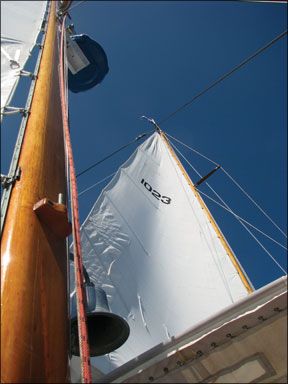I’m the happy owner of a 31-foot sloop, a replica of a 100-year-old wooden Friendship. Her fiberglass hull was laid up in a mold made from the old boat. My boat is very traditional, with wooden mast and spars, and lots of heavy bronze hardware on her gaff rig.
The mast and spars all need to be stripped and refinished this off-season, and the owner of the yard where she’s stored has recommended using Mas epoxy (www.masepoxies.com) as the base, then a coat of varnish, then a sprayed-on clear coat. The Mas people advised not to use an oil or mineral-based spar varnish, as it isn’t compatible with their product.

288
I want the traditional amber look to the finish. Is there a water-base varnish that has some color in it? What do you think about the Mas epoxy alternative to the customary six coats of varnish? The owner of the boatyard says that unlike other epoxies, Mas doesn’t get cloudy.
Capt. Jim Salmon
Friendship sloop
Center Conway, N.H.
There’s more to your question than simply finding a material with good adhesion and a durable, abrasion-resistant bright finish.
Soft woods see a lot of moisture-induced surface movement, and so coatings must be able to cope with the physical surface changes linked to dry, hot weather and the wet, cooler times of the year. That is why many people prefer relatively flexible spar varnishes for such applications. Although they’re less durable—from an abrasion-resistance perspective—than hard coatings like epoxy, they do give the wood that elegant amber look you’re going for.
Epoxy resin is the vice grip of all coating materials, but it has poor handling characteristics (flow, leveling, brushability) and no UV inhibitors. Mas Epoxies, however, are less viscous than most epoxies and tend to penetrate the substrate’s surface, making their flow out a little easier to control.
Using any epoxy as a base for an attractive wood finish is tricky. For one thing, it’s hard to sand without burning through, which will cause noticeable color changes when the topcoat is applied. And when the surface does fail, 85 percent of it will still be solidly stuck to the soft wood, and its removal or repair will be a major pain.
In our opinion, coating a mast with epoxy prior to varnishing and then topping off with a two-part coating is asking for more work down the road. The epoxy’s best attribute, its adhesive tenacity, is also its bane.
We recommend that you stick to just using a good spar varnish, or follow the Awlgrip approach that the pros use: Apply a few coats of Awlgrip’s Awlspar, an amber-hued phenolic tung-oil varnish, and then overcoat with the Alwgrip Awlbrite, a two-part clear acrylic urethane (www.awlgrip.com). Both can be found online; a quart of Awlspar costs about $30, but the Awlbrite comes with a hefty $70-per-quart pricetag.
If you opt for a different spar varnish, check out our series on exterior wood finishes to find out what will work best for you. We covered one- and two-part varnishes in the August 2007 and December 2007 issues, respectively. Updates to the long-term test can be found in the December 2009 issue and on page 26 of this issue.





































